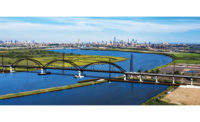
Logo design by Scott Hilling/ENR, some original logo elements by Getty Images
Navigating heavy train traffic and a swamp, crews have reached the halfway point on the $1.7-billion Portal North Bridge across the Hackensack River in New Jersey. The new 2.5-mile, fixed-span crossing that will replace a 114-year-old swing bridge is a key component of the $33.7-billion Gateway Program that will double rail capacity between Newark, N.J., and New York City.
Two years after New Jersey Transit awarded a $1.6-billion construction contract—the largest in the agency’s history—to a joint venture of Skanska and Traylor Brothers, the project is on time and budget, officials say. The scope of work includes retaining walls, deep foundations, concrete piers, structural steel bridge spans, rail systems and demolition of the existing bridge.
“The new bridge will increase train capacity by allowing travel speeds from 60 miles an hour to 90 miles an hour,” says Frank Corso, chief construction manager with NJ Transit, which oversees construction of the Amtrak-owned structure. Some 450 trains pass through each day.
The old 961-ft-long bridge, with a clearance barely more than 20 ft, has been a bottleneck due to sometimes getting stuck when opening to allow barge traffic through. “It opens maybe once a day, and doesn’t always close,” says Jim Driscoll, project manager with HNTB. HNTB is in a joint venture with Gannett Fleming Transit and Rail Solutions and Jacobs Engineering Group for the design of the 1,200-ft-long main span that consists of three tied arches, each 400 ft long by 57 ft wide by 86 ft high. Starting latest this year or early next year, the main span sections, prefabricated offsite, will be floated down the river and lifted into place. Each of the three sections will weigh about 2,700 tons.
“They will come through the existing Portal Bridge on a barge and brought into position to a transfer bent north of the new bridge,” says Brian Reilly, project director with the contracting team. “They’ll be jacked up into the air and pushed by tugboats onto a [construction] barge, onto the substructure and slid into place.”
Crews will then remove the existing falsework and start building the cast-in- place decks, he adds.
Settling Down
Mohammed Nasim, NJ Transit’s former chief of construction management, filed a lawsuit early this year in the Superior Courty of New Jersey alleging design defects including the dangers of track settlement and navigation issues.
Driscoll says that consideration of these issues are “baked into the design” and that there are extensive monitoring systems in place. “Stop-work limits and migitation procedures are built into the contract,” he says, noting that surveying prisms exist throughout the alignment.
“If anything moves, we see it in real time,” adds Gary Matz, HNTB group director. “They’re the first line of defense. If there’s any kind of concern, crews will go out” to address it.
Considering a “Meadow mat”—a highly compressible layer of organic material—there are a variety of retaining walls and piles. For example, one wall consists of cellular concrete fill topped by aggregate to allow for potential settlement. Foundations range from 2-ft-diameter pipe piles as deep as 100 ft and drilled shafts up to 10 ft in diameter.
In 2021, the project secured a $766.5-million full funding grant agreement to supplement multi-agency state funding. “It’s a good example of a generational investment that the country has made in railway infrastructure,” says Jason Hoover, Amtrak assistant vice president for bridges. “We have a number of programs that are going to utilize those funds to replace infrastructure that’s long overdue. It’s part of our bigger goal to expand ridership in the coming years.”
By Aileen Cho in the Meadowlands




Post a comment to this article
Report Abusive Comment